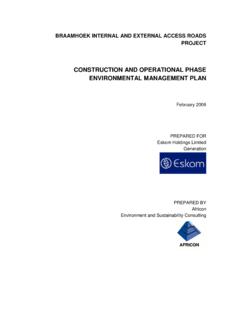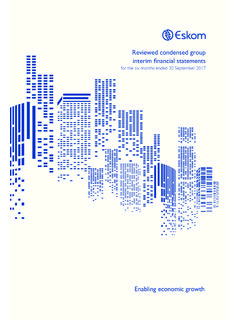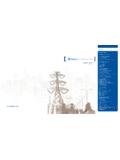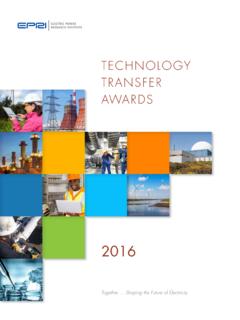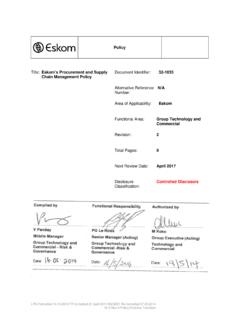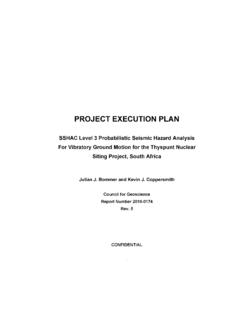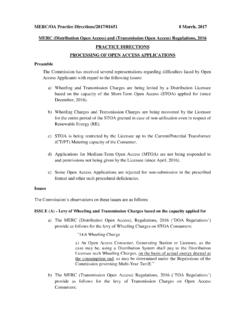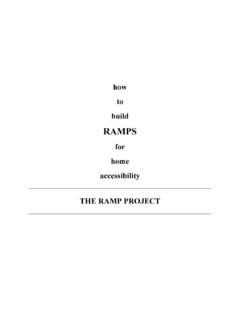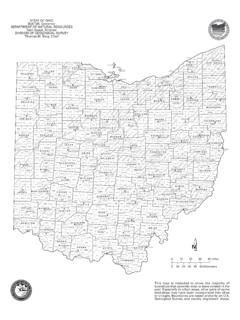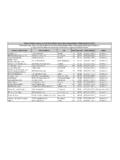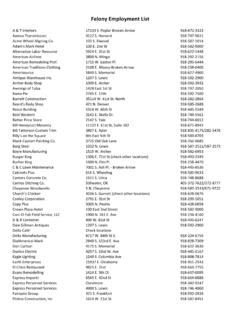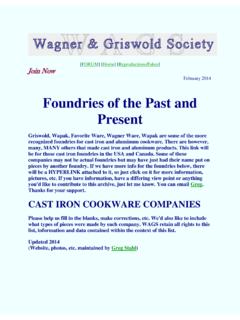Transcription of Wheeling/offset of energy - Eskom
1 Wheeling/offset of energyThe Eskom approach30 March 20112 Introduction Generators have the same non-discriminatory rights of access to the network as a load In the Code, Licence and ERA. Non- Eskom generators and Eskom generators are treated equally regarding access However generators have to be licensed to generated and trade before access can be provided Generators and loads are both customers of the network provider Loads pay published and approved charges for the use of the network These may be explicit unbundled charges or not! There is currently no regulated framework for use-of-system charges for embedded generators (generators connected to the Distribution network) Submitted to NERSA Some of these generators may sell to Eskom through approved power purchase agreements, whilst others may wish to wheel energy to third parties. Generators that wish to wheel energy face a number of challenges related to the use-of-system charges.
2 This presentation sets out the background on wheeling within the boundaries of South Africa3 What is wheeling of energy ?Its providing access between a non- Eskom Generator (NEG) and a third party to facilitate the trading of energyNon-EskomgeneratorLoadProduces energyBuys (non- Eskom ) energyEskom networkMeterMeterContract100 kWh100 kWh1000 kWhDeals with a financial flow of energy not not actual flowPays for the use of the networkPays for the use of the networkNot linked!!4 Transactions with generators The generator will contract with the network provider to provide network services. The network provider will raise charges for these services. The generator will contract with the entity purchasing the energy through a PPA and this may be with Eskom , a third party or for own generation. If the energy is sold to a third party, the electricity bill must be adjusted for the wheeled energy through a supplementary contract.
3 The customer will pay the standard tariffs associated with the cost of delivering the energy . All of the above transactions are separate contracts and deal with different issues. Use of systemcharges for GeneratorsUse of systemcharges for GeneratorsPPA betweengeneratorand buyerPPA betweengeneratorand buyerEnergy and use of system charges forLoadsEnergy and use of system charges forLoadsConnection and use of system agreementConnection and use of system agreementSale of energySale of energyElectricity supply agreementElectricity supply agreementAmendment to the Electricity supply agreementAmendment to the Electricity supply agreementWheelingWheeling5 Conditions for providing wheeling Eskom will allow wheeling of energy subject to wheeling subject to NERSA approvals Licensing, registration etc Connection subject to NERSA approvals and signing of a connection and use of system agreement The account(s) will be adjusted in terms of Eskom s policy on the reconciliation of accounts The third party access will be implemented initially up to an overall limit of 300 MW and the capacity of a NEG will not exceed 300 MW (currently being revised).
4 A generator will not connect at low-voltage (<1 kV) 6 wheeling charges wheeling charges are not something special or different they are the standardnetwork related tariff charges for the use of the network There is no link made in the network charges between what the generator produces and what the load buys - the charges payable for the use of the network are NOT dependant on who supplies the energy The generator is charged for what is exported - at standard GUOS tariffs The load is charged for what is delivered over the Eskom network - at standard tariffs Any use-of-system benefit or cost associated with a generator s location accrues to that generator and not to the purchaser of the energy as per the GUOS framework A customer receiving wheeled energy will pay the same tariff charges for the use of the network as a customer that purchases all its energy from Eskom no discrimination These charges comprise network charges, the cost of losses.
5 Reliability services and for loads the associated levies Contribution to socio-economic subsidies will not be avoided by a wheeling arrangement There is no credit given for network related charges in particular network demand charges The network demand charges recover only network related costs not any energy costs Some costs are recovered as energy based charges, but they are not related to energy cost (like the ERS) A wheeling arrangement does not reduce the capacity required on the network!7 Use of system charges - allocation of network charges between loads and generatorsBuys (non- Eskom ) energyMeterMeter100 kWh100 kWh1000 kWhBoth loads will payequitably for the networkusageLoad B Load AGenerator A Generator B MeterMeterBoth generators will payequitably for networkusageSum of all load and generator network charges = Distribution/Transmission revenue requirement GeneratorR/kW network charge GeneratorR/kW network charge Load R/kVAnetwork charge Load R/kVA network chargeLoad R/kVA network charge8 Charges payable by loadsLoads+ Network chargesTransmissionDistribution+ LossesTransmissionDistribution+ Reliability servicesSystem ops+ Electrification and rural subsidyDistribution+ Connection chargesTransmissionDistribution+ Service and adminchargesTransmissionDistribution9 Charges payable by generators Generators+ Network charges+ /-Losses+ Reliability services+ Connection charges+ Service and adminchargesTransmissionDistributionTran smissionDistributionSystem
6 OpsTransmissionDistributionTransmissionD istributionFramework still to be developed and approved by NERSA10 The purchaser of energy (the load) will receive a financial credit on its Eskom account for the net energy sent out by the Generator. A contract will have to be signed to facilitate the wheeling transaction. This will deal with the addition or subtraction of energy depending on the scenario Will use the same meter data as measured at the generator This is loaded as a new service agreement on the main account. The cost of the energy bought directly from Eskom is paid at standard tariff rates (as per the supply agreement). An energy credit given to the purchaser (load) is at the Megaflex energy charges less losses and reliability service charge (the base rate) based on what the generator has allocated to the load Losses and reliability services network costs are therefore charged on energy delivered at the standard tariff rates as the credit excludes these costs The electrification and rural subsidy is payable on all delivered energy Network charges are payable on all energy delivered over Eskom s networks based utilised capacity and maximum demands The environmental levy charge is payable only Eskom owned of accounts - wheeling11 Treatment of costs of losses under wheeling Technical losses are a network related costs The load (purchaser) will pay for losses at the published loss factors for the energy wheeled Eskom will not calculate the actual cost of losses from the generator to the load!
7 The load purchasing energy from a non- Eskom generator will not be treated differently from a load purchasing energy from Eskom . The charge for losses is currently bundled in the energy rates (not explicit) The energy wheeled will deducted on the bill at the Megaflex Eskom tariff rates (average cost) excluding losses and reliability services. The benefit or cost of losses due to the generator (as applicable) will accrue to the generator not the of losses The amount of energy produced by Eskom generation is higher than amount of energy sold to the end consumer. This is due to technical losses. Technical losses are a network related costs (to cover the difference between the amount produced and the amount sold) This cost needs to be recovered from all customers Actual losses per customer are not calculated average loss factors are determined. Losses and loss factors are determined by voltage and the geographic location (Transmission Zone) The lower the voltage the higher the losses (electricity has to travel greater distances) The further away from Mpumalanga the greater the losses (the centre of generation capacity) Generation that connects to the Distribution network reduces Distribution losses The benefit increases if generators connect further away from Mpumalanga and at lower voltagesVoltage differentiationGeographic differentiation100851009413 Summary of wheeling charges payableLoad will pay subsidies on all energy delivered over the Eskom networkFinancial credit is calculated as.
8 The energy produced by the generator in P, S, O periods x Megaflex energy rates less losses and reliability servicesReceives a financial credit for energy bought/received from generatorPays standard tariff loss factorsLosses benefit accrues to generatorUse-of-system charges not linked to the wheeling arrangementUse-of-system charges not linked to the wheeling arrangementPays use-of-system charges applicable to loadsPays use-of-system charges applicable to generatorsLoad/purchaserGenerator14 Example of a reconciliation1516 Eskom also allows offsetting Generator produces for own use, but at times may be export energy onto the network Does not want to sell this energy to Eskom , but would like a credit on the account for the energy of energy Generator supplies portion of its energy directly to its customer via its network. At times the generator exports surplus generated energy onto Eskom s network.
9 Eskom does not buy this energy but a financial credit adjustment is given to the customer (in lieu of purchasing the energy ) at the standard tariff rates in TOU period Typically Generator and customer same legal entity/company situated at same location. Credit adjustment at the contracted tariff energy rates in each TOU period, voltage level & Txzone. Must be additional generation capacity installed by Generator and not more than 10% of load. Requires bi-directional meteringImportExportEskom (import)1900 kWhCustomer total consumption2000 kWhNEG250 kWh generatedMeter1900 kWhGenerator (export)250 kWh150 kWh18 Offset exampl
